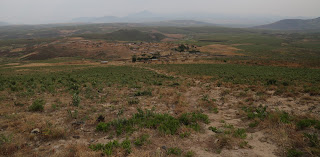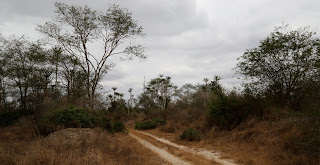Angola was of course torn apart by more than
two decades of civil war.
Signs of it are everywhere.
Most villages we passed through had many ruins in it.
We left early on the morning of 16th September, with a couple
of roadside stops in miombo woodland & we saw Sharp-tailed Starling from
the roadside. Arrived at Chipipa after nine hours on the road & booked into
our pleasant ranch for the next four nights.
We managed to see a fine Rufous-bellied Heron on a roadside pond (always a good species to get). Raptors proved to be scarce in Angola, but today provided a couple of Bateleurs a Martial Eagle & a Red-necked Buzzard. Two Meyer's Parrots flew by & a couple of parties of White-tailed Shrikes was welcome. Close views of around 25 Red-throated Cliff Swallows was a bonus. A Sooty Chat was in some agricultural land. Two pairs of Western Violet-backed Sunbirds & two Wood Pipits showed nicely in the miombo woodland.
We managed to see a fine Rufous-bellied Heron on a roadside pond (always a good species to get). Raptors proved to be scarce in Angola, but today provided a couple of Bateleurs a Martial Eagle & a Red-necked Buzzard. Two Meyer's Parrots flew by & a couple of parties of White-tailed Shrikes was welcome. Close views of around 25 Red-throated Cliff Swallows was a bonus. A Sooty Chat was in some agricultural land. Two pairs of Western Violet-backed Sunbirds & two Wood Pipits showed nicely in the miombo woodland.
17th September was a drive to Mount Moco & we birded the
flanks of the mountain in some afro-montane forest which was very productive. Highlights included:
2 African Marsh Harrier; 2 Augur & a Red-necked Buzzard; 2 Schalow's Turaco; Western Tinkerbird; Black-backed Barbet; 2 Red-throated Wryneck; White-tailed Blue Flycatcher; Angolan Lark which displayed right in front of us! Fan-tailed Grassbird; Grey Apalis; African Hill Babbler; African Spotted Creeper; Angolan Slaty Flycatcher; the brilliant Bocage's Akalat; Bronzy Sunbird; several Oustalet's Sunbirds; 2 Black-chinned Weaver; at least 10 Dusky Twinspot & 3 Angolan Waxbill.
In the afternoon we birded miombo woodland & some fields & scrub
near the road. Best were:
Green-backed Honeybird; Black throated Wattle-eye; White-winged Black Tit; Black & Rufous Swallow; Moustached Grass Warbler; Miombo Wren-Warbler; 3 species of Eremomela including Salvadori's! Two Yellow-bellied Hyliota; male & female Bocage's Sunbird & four Fulleborn's Longclaw.
On 18th September drove to Londvimbala, birded the road near
Galanga. Several stops in open areas with streams in valley bottoms & a
couple of stops in miombo woodland in the afternoon.
Highlights: 2 Dark Chanting Goshawk; Coppery-tailed Coucal; 2 Blue-breasted Bee-eater; Miombo Pied Barbet; 6 Black & Rufous Swallow; Chirping Cisticola; around six Black-necked Eremomela; Hartlaub's Babbler; Sharp-tailed Starling; Miombo Scrub Robin which performed quite well; 2 Bocage's Sunbirds; 7 Bocage's Weaver; a fine flock of Marsh Widowbirds; nine Locust Finch and Black-faced Canary.
Highlights: 2 Dark Chanting Goshawk; Coppery-tailed Coucal; 2 Blue-breasted Bee-eater; Miombo Pied Barbet; 6 Black & Rufous Swallow; Chirping Cisticola; around six Black-necked Eremomela; Hartlaub's Babbler; Sharp-tailed Starling; Miombo Scrub Robin which performed quite well; 2 Bocage's Sunbirds; 7 Bocage's Weaver; a fine flock of Marsh Widowbirds; nine Locust Finch and Black-faced Canary.
19th September was the long walk on Mount Moco. Walking up to
upland grassland & afro-montane forest patches. Some nice scenery on the
mountain. Back down by 3 pm & then drove back to Chipipa, with a stop along
the river.
Highlights: Finch's Francolin (for some)! Schalow's Turaco; a pair of the very beautiful Margaret's Batis; Hartlaub's Babbler; Bocage's Akalat; 10 Mountain Wheatear of the endemic race nigricauda; Long billed Pipit & Yellow-crowned Canary.
Highlights: Finch's Francolin (for some)! Schalow's Turaco; a pair of the very beautiful Margaret's Batis; Hartlaub's Babbler; Bocage's Akalat; 10 Mountain Wheatear of the endemic race nigricauda; Long billed Pipit & Yellow-crowned Canary.
Not understanding Portuguese is a bit of a problem here!
Basically it says when you are outside the beauticians
you are ugly, but when you leave you are beautiful!
Further reminders of the war!
Not very PC Keith!
A lot of fun though!
Boys & their toys!
20th September was a travel day but made a stop along a small
stream for Brazza’s Martin, then another walk through miombo woodland, before
driving to Condo in the afternoon & late afternoon/early evening birding
neat the hotel in dry forest & small scale cultivation patches.
Highlights included: Ayer's Hawk Eagle; the stunning Red-crested Turaco; Monteiro's Bushshrike; White-breasted Cuckooshrike; 2 Rufous-bellied Tit; Falkenstein's Greenbul; Red capped Crombec; Superb Sunbird & 8 Black-necked Weaver.
Enjoyed a nice dinner, with John reaching his 8,000th bird species! A real milestone! Congratulations mate!
Highlights included: Ayer's Hawk Eagle; the stunning Red-crested Turaco; Monteiro's Bushshrike; White-breasted Cuckooshrike; 2 Rufous-bellied Tit; Falkenstein's Greenbul; Red capped Crombec; Superb Sunbird & 8 Black-necked Weaver.
Enjoyed a nice dinner, with John reaching his 8,000th bird species! A real milestone! Congratulations mate!
This escarpment forest is getting really trashed.
Slash & burn cultivation rules here!
The villages had burned the forest next to the road
which had felled a tree across the only road
to their village!
21st September was spent in the Kumbira Forest, which is very
cut-over & getting totally destroyed fast! It was hard to find the three
specials, but we did in the end!
Highlights: 5 Red-crested Turaco; Gabon Coucal; 10 Mottled Spinetail; African Pygmy Kingfisher; Yellow-rumped Tinkerbird; Hairy-breasted Barbet; Buff-spotted Woodpecker; 2 Brown-eared Woodpecker; Elliot's Woodpecker; 2 African Broadbill (great views of them displaying); Angolan Batis; Yellow-bellied Wattle-eye; Many coloured Bushsrike; 2 Gabela Bushshrike; Petit's Cuckooshrike; 5 Dusky Tit; Yellow-throated Nicator; Pulitzer's Longbill; Lowland Masked Apalis; Buff-throated Apalis; Brown Illadopsis; 8 Southern Hyliota; Fraser's Rufous Thrush; Forest Scrub Robin; 3 Gabala Akalat; Little Green Sunbird & Grey-headed Nigrita.
Highlights: 5 Red-crested Turaco; Gabon Coucal; 10 Mottled Spinetail; African Pygmy Kingfisher; Yellow-rumped Tinkerbird; Hairy-breasted Barbet; Buff-spotted Woodpecker; 2 Brown-eared Woodpecker; Elliot's Woodpecker; 2 African Broadbill (great views of them displaying); Angolan Batis; Yellow-bellied Wattle-eye; Many coloured Bushsrike; 2 Gabela Bushshrike; Petit's Cuckooshrike; 5 Dusky Tit; Yellow-throated Nicator; Pulitzer's Longbill; Lowland Masked Apalis; Buff-throated Apalis; Brown Illadopsis; 8 Southern Hyliota; Fraser's Rufous Thrush; Forest Scrub Robin; 3 Gabala Akalat; Little Green Sunbird & Grey-headed Nigrita.
The next day was a travel day on the road to Kalandula. Road was very
bad in places & progress was slow. We had a couple of stops & I saw a
Red chested Flufftail very briefly ( four heard) + two Grey Waxbills at lunch.
Other good species included: Red-backed Mousebird; Elliot's Woodpecker; 15+ Angolan Swallow; Bubbling Cisticola; Brown Twinspot & Landana Firefinch.
Other good species included: Red-backed Mousebird; Elliot's Woodpecker; 15+ Angolan Swallow; Bubbling Cisticola; Brown Twinspot & Landana Firefinch.
It was raining on the morning of 23rd September & we drove
about 30 kms north of Kalandula to an area of gallery forest, where we birded
for the next three hours. Highlight here was the amazing White-headed Robin
Chat!
Other species included: 35+ Mottled Swift; Broad-billed Roller; African Hobby; 5 Cabanis's Greenbul; Whistling Cisticola; 2 Bannerman's Sunbird; 2 Orange-winged Pytilia; Brown Twinspot & Landana Firefinch.
Other species included: 35+ Mottled Swift; Broad-billed Roller; African Hobby; 5 Cabanis's Greenbul; Whistling Cisticola; 2 Bannerman's Sunbird; 2 Orange-winged Pytilia; Brown Twinspot & Landana Firefinch.
The rest of the day was spent birding miombo woodland in the heat.
Birding was slow but rewarding: Pale billed Hornbill; 8 Anchieta’s Barbets;
Anchieta’s (Marsh) Tchagra; Brown headed Apalis & Anchieta’s Sunbird were the
highlights.
Dusk was spent on the Lucala
Bridge overlooking marshes & grassland. 500 + Red throated Cliff
Swallows & 300 Little Swifts were nesting under the bridge.
On 24th, we again birded the miombo woodland of yesterday,
then briefly visited the Kalundula Falls, (which were impressive).
Highlights included: Black-chested Snake Eagle; Blue-spotted Wood Dove; 2 Ross's Turaco; 250+ Common Swift; 3 Meyer's Parrot; White-breasted Cuckooshrike; Black Cuckooshrike; Bates's Sunbird & Landana Firefinch.
Highlights included: Black-chested Snake Eagle; Blue-spotted Wood Dove; 2 Ross's Turaco; 250+ Common Swift; 3 Meyer's Parrot; White-breasted Cuckooshrike; Black Cuckooshrike; Bates's Sunbird & Landana Firefinch.
The next five hours was spend driving to Uige, but we had a good birding
stop in remnant forest about 15 kms. East of Uige.
Crowned Eagle; Ayer's Hawk Eagle; Brown-eared Woodpecker; 2 Braun's Bushshrike; 4 Falkenstein's Greenbul; Yellow-throated Leaf-Dove; 3 Cabanis's Greenbul; Black-collared Bulbul; White-chinned Prinia; Black-throated Apalis; Grey-chinned Sunbird; Carmelite Sunbird; Orange-tufted Sunbird; Red-headed Malimbe; White-breasted & Grey-headed Negritas.
Crowned Eagle; Ayer's Hawk Eagle; Brown-eared Woodpecker; 2 Braun's Bushshrike; 4 Falkenstein's Greenbul; Yellow-throated Leaf-Dove; 3 Cabanis's Greenbul; Black-collared Bulbul; White-chinned Prinia; Black-throated Apalis; Grey-chinned Sunbird; Carmelite Sunbird; Orange-tufted Sunbird; Red-headed Malimbe; White-breasted & Grey-headed Negritas.
On 25th we birded a patch of forest around 15 kms south of
Quitexe, which was very birdy & productive.
Highlights: Great Blue Turaco; Guinea Turaco; African Pygmy Kingfisher; Black Bee-eater; 10 Piping Hornbill; 2 Speckled Tinkerbird; Red-rumped Tinkerbird; 4 Hairy-breasted Barbet; Green-backed, Buff spotted & Brown-eared Woodpeckers; Red-fronted Parrot; 2 Chestnut Wattle-eye; 4 Pink-footed Puffback; 3 Braun's Bushshrike; Purple-throated Cuckshrike; 4 Black-winged Oriole; Velvet-mantled Drongo; Blue-headed crested Flycatcher; African Blue Flycatcher; Honeyguide Greenbul; Banded Prinia; Yellow-browed Camaroptera; 7 Rufous-crowned Eremomela; 4 Narrow-tailed Starling; 2 Dusky Blue Flycatcher; Crested Malimbe; Yellow mantled Widowbird; Pale-fronted Negrita; Red-headed Bluebill & 13 Black & White Mannikin.
We left Uige at 6 am & drove to Quibaxe, an area of mixed cut over forest. Birding was productive but then we moved on & the rest of the day was all driving.
Best birds were: Afep Pigeon; 2 Red-crested Turaco; 2 Black-casqued Hornbill; 4 Naked-faced Barbet; Yellow-billed Barbet; 15 Red-fronted Parrot; 2 Bocage's Bushshrike; Yellow-throated Nicator; Orange-tufted Sunbird; 10 Brown Twinspot & Black-faced Canary.
Then the trip was all over! This was a superb trip, excellently lead by Michael Mills.
Highlights: Great Blue Turaco; Guinea Turaco; African Pygmy Kingfisher; Black Bee-eater; 10 Piping Hornbill; 2 Speckled Tinkerbird; Red-rumped Tinkerbird; 4 Hairy-breasted Barbet; Green-backed, Buff spotted & Brown-eared Woodpeckers; Red-fronted Parrot; 2 Chestnut Wattle-eye; 4 Pink-footed Puffback; 3 Braun's Bushshrike; Purple-throated Cuckshrike; 4 Black-winged Oriole; Velvet-mantled Drongo; Blue-headed crested Flycatcher; African Blue Flycatcher; Honeyguide Greenbul; Banded Prinia; Yellow-browed Camaroptera; 7 Rufous-crowned Eremomela; 4 Narrow-tailed Starling; 2 Dusky Blue Flycatcher; Crested Malimbe; Yellow mantled Widowbird; Pale-fronted Negrita; Red-headed Bluebill & 13 Black & White Mannikin.
We left Uige at 6 am & drove to Quibaxe, an area of mixed cut over forest. Birding was productive but then we moved on & the rest of the day was all driving.
Best birds were: Afep Pigeon; 2 Red-crested Turaco; 2 Black-casqued Hornbill; 4 Naked-faced Barbet; Yellow-billed Barbet; 15 Red-fronted Parrot; 2 Bocage's Bushshrike; Yellow-throated Nicator; Orange-tufted Sunbird; 10 Brown Twinspot & Black-faced Canary.
Then the trip was all over! This was a superb trip, excellently lead by Michael Mills.




















































































